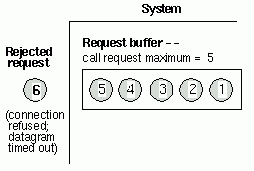
Call requests for RPC servers come into the RPC runtime over the network. For each endpoint that a server registers (for a given protocol sequence), the runtime sets up a separate request buffer. A request buffer is a first-in, first-out queue where an RPC system temporarily stores call requests that arrive at an endpoint of an RPC server. The request buffers allow the runtime to continue to accept requests during heavy activity. However, a request buffer may fill up temporarily, causing the system to reject incoming requests until the server fetches the next request from the buffer. In this case, the calling client can try again, with the same server or a different server. The client does not know why the call is rejected, nor does the client know when a server is available again.
Each server process regularly dequeues requests, one by one, from all of its request buffers. At this point, the server process recognizes them as incoming calls. The interval for removing requests from the buffers depends on the activities of the system and of the server process.
How the runtime handles a given request depends partly on the communications protocol over which it arrives, as follows:
· A call over a connectionless transport is routed by the server's system to the call request buffer for the endpoint specified in the call.
· A call over a connection-oriented transport may be routed by the server's system to a request buffer or the call may go directly to the server process.
Whether a remote procedure call goes to the request buffer depends on whether the client sends the call over an established connection. If a client makes a remote procedure call without an established connection, the server's system treats the call request as a connection request and places the call request into a request buffer. If an established connection is available, the client uses it for the remote procedure call; the system handles the call as an incoming call and sends it directly to the server process that owns the connection.
Whether a server gets an incoming call from a request buffer or over an existing connection, the server process manages the call identically. A server process applies a clear set of call-routing criteria to decide whether to dispatch a call immediately, queue it, or reject it (if the server is extremely busy). These call-routing criteria are discussed in Queuing Incoming Calls .
When telling the RPC runtime to use a protocol sequence, a server specifies the number of calls it can buffer for the specified communications protocol (at a given endpoint). Usually, it is best for a server to specify a default buffer size, represented by a literal whose underlying value depends on the communications protocol. The default equals the capacity of a single socket used for the protocol by the server's system.
The default usually is adequate to allow the RPC runtime to accept all the incoming call requests. For a well-known endpoint, the size of a request buffer cannot exceed the capacity of a single socket descriptor (the default size); specifying a higher number causes a runtime error. For well-known endpoints, specify the default for the maximum number of call requests.
For example, consider the request buffer at full capacity as represented in the following figure. This buffer has the capacity to store five requests. In this example, the buffer is full, and the runtime rejects incoming requests, as is happening to the sixth request.
A Request Buffer at Full Capacity
